Last updated: June 12, 2024
Article
Preserving the Historic Military Landscape at Camp Adair
This is a transcript of a presentation at the Preserving U.S. Military Heritage: World War II to the Cold War, June 4-6, 2019, held in Fredericksburg, TX. Watch a non-audio described version of the presentation on YouTube.
Preserving the Historic Military Landscape at Camp Adair
Presenter: Rick Minor and Kathryn Anne Toepel
Abstract
Camp Adair in the Willamette Valley of northwestern Oregon was one of 25 new cantonments constructed nationally for the U.S. Army between 1940 and 1942. These cantonments were characterized by the speedy construction of low-cost temporary buildings designed to house and train millions of men quickly. Within a military reservation of over 56,000 acres, the cantonment at Camp Adair contained headquarters, barracks, and support buildings, including over 1,400 structures. Four infantry divisions trained for combat at Camp Adair, and at its peak from 1942 to 1944 when two divisions were training at the same time, Camp Adair had a population of approximately 40,000, making it the second largest city in Oregon.
After the war, Camp Adair was declared surplus, and most of the land was reacquired by previous owners or transferred to federal and state agencies. Almost all of the buildings were removed, leaving the street grid and concrete piers, pads, foundations, and chimneys as the primary reminders of the cantonment. In 1950, a sizable portion of the former cantonment became the E.E. Wilson Wildlife Area managed by the Oregon Department of Fish and Wildlife (ODFW). The continued existence of the Camp Adair cantonment may be at odds with the needs of ODFW, which has considered removal of most of the physical evidence to enhance rabbit and bird habitat for hunters.
Today, the cantonment’s footprint (recorded as historical archaeological site 35BE158) stands out clearly on the landscape. The site encompasses 1,745 acres, of which 1,415 acres (81%) are within the 1,683 acres of the Wildlife Area, with an estimated 330 acres in other ownership. A total of 1,432 Camp Adair structures were within the cantonment, with 1,117 (78%) on land now managed by ODFW and 315 (22%) on land owned by others.
The distribution of the highly visible building foundations within the street grid reflects the redundant patterning typical of World War II cantonments. With map in hand it is possible to drive down the streets and identify the building that stood at each foundation. This patterning is so expansive and pervasive that it transcends identification as an archaeological site and is more accurately characterized as a historic cultural landscape, more specifically as a historic military landscape. The Camp Adair landscape may represent the most intact example of the footprint of a U.S. Army World War II cantonment still in existence.
Each of the four infantry divisions that trained at Camp Adair (70th, 91st, 96th, 104th) went on to distinguished combat records. Altogether, 26,436 men from these four divisions were killed in battle, with more than 20,000 wounded. Nine soldiers were awarded the Medal of Honor. The Camp Adair landscape is a visual reminder honoring the sacrifices made by the men who trained there. As an interpretive anchor that has attracted many former soldiers and civilians to visit and reflect on their experiences during the war, the historic military landscape at Camp Adair is a poignant memorial to Oregon’s role in the U.S. military’s mobilization during World War II.
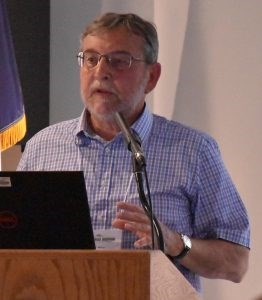
Presentation
Rick Minor: There we go. So this morning we heard these really excellent presentations on research that is pretty far along. This is going to be a real contrast, because this represents basically the first research that's been done at Camp Adair. Many of the most enduring memories for the literally millions of men and women who were drawn into the nation’s mass mobilization at the beginning of World War II, were from their time in training camps. And in 1941 and '42, to accommodate the influx of these people, the army established 59 new training camps in 28 different states. These were always intended to be temporary, and after the war 46 of the 59 were declared surplus, fell out of government ownership, and they usually end up; all the buildings are demolished and the land is subdivided, redeveloped and used for other purposes.
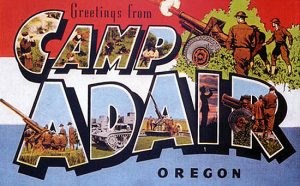
Camp Adair was one of these new camps. It was a built from scratch camp and where troops trained for combat during World War II. And the most accessible history is this book from John Baker, he's not there yet.
All right, I’ll start over. Keep Mary away from me. Starting over. Oh come on.
Okay, the most accessible history is this book by John H. Baker, privately published in 2004, in which he mentions that thousands of family and friends received news of their loved ones on this "Greetings From Camp Adair" postcard. All right, we're rolling. Not sure how much you can see in this. This is the Camp Adair cantonment in 1942. The word cantonment has been used in a couple different ways. Sometimes it's used to refer to the entire military reservation, but more often it's used to refer to that smaller part where the headquarters and the barracks and the support buildings are located and that's how we use it here. The Camp Adair cantonment consisted of two parts. Almost all the buildings in this, particularly on the north side are part of the main camp area, and then the second part was the hospital, which is three quarters a mile to the south. So the main camp area had something like 1400 buildings. The hospital had another 400. Together 1800 or so, and when two divisions were training here between 1942 and 1944, the total population was around 40,000, which makes it the second largest city in Oregon at that time for a short time, second to Portland.
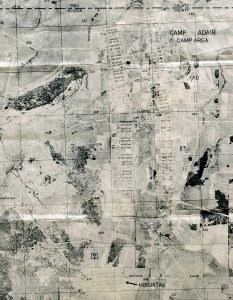
So you might notice that dark blotch up in the upper left. That's this low mountain that played a prominent role in the lore of the soldiers who trained here. So if you remember in Band of Brothers, they spend a lot of time training by running up and down Currahee, the local mountain. In this here, they were running up and down this mountain, which had the unfortunate name for troops who were going into combat, many of whom were going to be killed, of Coffin Butte. Not good.
So, initially after the war, the trajectory for Camp Adair follows that of most of the other training camps. The land is declared surplus, most of the buildings are removed and it's sort of facing redevelopment. But in 1950, things take a turn when the main camp area becomes the E. E. Wilson Wildlife Area. And they managed it now, they still manage it, but they managed to do not too much damage. There's some, I don't have time to get into, but in 2015 they decided to aggressively pursue ripping out almost all the remnants of World War II structures on the site and that's where we came in. Somebody suggested that they really ought to do an archeological historical assessment first, and so we got to do that, and I struggled with how to describe our findings. And I thought about using some archeological jargon, but so I'll simply say we were blown away by what we saw.
The road system is still really intact, and we saw the remains in the form of concrete piers and pads, and platforms and etcetera of several hundred structures out there. So we recorded it as an archeological site, which quickly was determined National Register eligible, and what we think we have there is the most complete footprint of a U.S. Army training cantonment from World War II.
Okay, so the Corvallis area was determined as a potential site for a training camp by the army in July 1941, some four months before Pearl Harbor. And you might be able to pick out Corvallis in the northwest quadrant of the map, midway between Portland and Eugene. But they hadn't decided on a specific point until mid-August of '41, when they decided on the Wells Camp area. So Wells was a small community along the Southern Pacific Railroad Line that had a depot, maybe a dozen houses, and a street grid, and a school. It was very characteristic of settlement in that part of the Willamette Valley before the war. Unfortunately for Wells, it was right in the middle of the new cantonment. It gets obliterated.
So the total Camp Adair reservation was over 56,000 acres, straddling Highway 99, which doesn't show up very well here, between Corvallis and Monmouth. The cantonment is in the southeast corner, as you can see. The training ranges, artillery ranges, maneuver areas are to the northwest. So in order to create this reservation, they had to move out 6,000 people, mostly small farmers, and some 600 school children, and they even relocated 10 cemeteries.
So World War II military construction focused mainly on temporary buildings made from plans like these, developed by the Army's quartermaster core. And the tight deadlines, crews of masons, carpenters, electricians, etcetera would move from building to building, rapidly constructing the new buildings. And this assembly line approach was later adopted by developers in the post-war period. So although these buildings are rapidly built, they're not shoddy by any means, and in fact studies in the 1990s found that more than 26,000 temporary World War II buildings were still standing on Department of Defense installations into the 1990s.
So as an example of the rapid construction, the headquarters building in the background here was constructed in 20 days. So here's what the cantonment looks like in 1944, probably maximum extent. And a couple things to point out is the headquarters is roughly in the center there and then the two sides are very similar, almost mirror images of each other, and one division was housed on one side, and one division could be housed on the other. One of the other things about this is that, as we did our study there's a tendency to think of all of these black dots as basically the same, but there's at least 80 to 100 different functional building types represented in this plan. And this is an example, if you've worked on military bases before you know they have tons of really great maps. So you can literally take these maps and go down the streets today and identify the function of every concrete structure that you see.
So the barrack has been described as the most representative example of army construction. At Camp Adair they had the 800 series barracks, which is supposed to have the new innovation of forced air heating but at Camp Adair they were still using coal fired stoves.
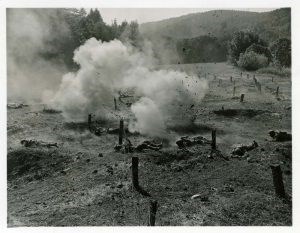
Everybody likes to hear about combat training. These divisions were the triangular divisions. They each had three rifle regiments and each of which had three rifle battalions. And each division was supposed to be about 15,500 people with artillery, infantry, and engineering units associated plus support troops. They trained in small arms, explosives, use of mortars, anti-tank guns, anti-aircraft guns, they did maneuvers with tanks, and they did work with spotter planes for artillery. Let's see, what else? Three of the four divisions were there for between 10 and 12 months, so this was pretty intensive training. The fourth left after three months to go to Fort Leonard Wood to complete their training before they shipped out.
One local resident noted that it was really noisy around there. So you might have heard it rains a lot in Oregon. It's kind of true, and the winters of '42/'43 and '43/'44 were very severe. There's a lot of standing water, and so some of the troops started referring to Camp Adair as "Swamp Adair".
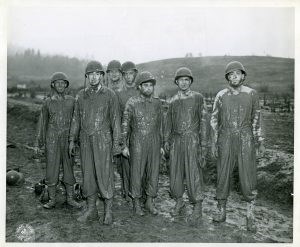
So after the last division leaves in July 1944, the camp was used for POWs, and as you can see they were Italians, they were first, and then later there were Germans there. And some reports that they might have been as many as 1200 Germans at the maximum time, and they apparently helped out a lot in the agricultural harvest. But interesting to note there were Germans there almost a full year after the end of the war in Europe.
So in the post-war period, as I mentioned, it's declared a surplus, the next year in 1947 they start dismantling the buildings. There's still lots of reports of houses that were made in the Willamette Valley from materials that were at Camp Adair. One of the most popular buildings for actually picking up and moving were the chapels, and there's one in that lower right photograph. These were distributed around Western Oregon, and one of them even made it as far as Crescent City in Northern California.
So in 1950, this is a photograph of 1950, most of the structures are gone from the west half of the area. The ones on the right that are still standing were in an area that the National Guard took over for a while. So this is what it looked like when the Oregon Department of Fish and Wildlife took it over.
So here's sort of what we came up with for what is actually now within the wildlife area. The purple line is the wildlife area, and you can see the dotted line was the former cantonment. And a couple statistics, approximately 1,415 of the 1,683 acres, which is actually 84%, not 81%, are in the wildlife area. And over something like 1,117 structures or 78% of those that were once present of the 1,432 are within this area. So we've got the bulk of the former cantonment is within the wildlife area.
So there's at least five buildings from World War II still standing. The most impressive is this heavy equipment shop, has one of those sliding lifts for lifting engines out of tanks and other heavy equipment. The other four look a lot like this motor repair shop. And I was allowed to go into this, one of these buildings, and it was like walking into a tomb, not in a negative sense, but in the sense that you had the impression that you walked into a place that nobody's been in for 65 years. They just walked away, shut the door and walked away. So it's very well preserved.
So mostly what the archeological record looks like now is hundreds of these concrete pads, piers, etcetera scattered across the landscape. I could provide a lot more pictures but this will sort of give you an idea. So I was going to present an aerial photo, but it doesn't really capture much because of the vegetation, but if you strip away the vegetation on this lidar image, and get a sense of the micro topography, it all just sort of comes out at you. And it shows that we have so much more than what we might think of as an archeological site, we actually have a cultural landscape. And this cultural landscape can be more specifically defined as a historic military landscape, and there's five criteria, let's see if I can remember them. One of them, the first is military mission, second is sight layout, sighting and layout, third is military traditions and cultural values, four is high degree of similarity as reflected in redundant construction elements, building elements, and five is restricted access. So certainly four of the five characteristics are readily apparent at this place. The restricted access, the fences are down, sentry posts are down, but you can still get a sense that there was a restricted access because there's very few entrance roads.
So let's talk about the divisions briefly. I didn't put these in any particular order. There's these four divisions that train there. The 96th Division I'm thinking they trained and trained assuming they were going to go to Europe, they get sent to the Pacific, and they were involved in the invasion of Leyte Island when MacArthur returned to the Philippines. On the right side is the 70th Division, they get sent to Italy. One part of that division fought at Anzio and then the rest of it joins in, and at the end of the war they're in Northern Italy fighting the Germans there. The two divisions in the center fought in France, Belgium, and Germany, and they come in after D-Day as sort of relief for the initial divisions that had fought. So with this remove in time we often don't think about the deaths, the numbers, and I don't know if you can see it but if you add up those battle deaths there's over 26,000 battle deaths from these four divisions. There's another 475, I think it is, that are classified as missing, if you add those in you get up to about 27,000. To me that's a pretty humongous number.
You can also see some of the awards. There were nine Medal of Honor winners trained at Camp Adair. Lots of Silver Stars, other decorations. Very impressive records. After the war, the three divisions that went to Europe come back and are deactivated by the end of 1945. The fourth division that went to the Pacific comes back and gets deactivated in February 1946.
So landscapes have many layers, and that's certainly true of the one at Camp Adair. And first thing is the landscape of memory. This place had so much impact on the lives of these guys that after the war, a lot of them came back to tour the site. And that really well preserved street grid, and this abundance of concrete ruins served as interpretive anchors for these people, they could literally go to where they had lived and done various things. But there's been very little interpretation. These signs for example were all that identified the site in the 1950s, this stood along Highway 99 at the time when most of the guys were coming back.
So it's difficult today to remember as we look at this bucolic landscape we're viewing to the west. These are concrete piers from former barracks, Coffin Butte is in the background, it's hard to remember that this was a landscape of conflict. This is where these guys learned how to fight, and I think we need to remember that. And this is an example of these training camps were important parts of the military organization, and that was characteristic of this industrial warfare in the mid '40s, in the 1940s that had an affect not only on the soldiers in the military but also on the civilian population as well.
So with the passage of time, landscapes of memory and landscapes of conflict often become landscapes of commemoration and memorial. And as we get farther and farther from the 1940s, preservation of landscapes like at Camp Adair take on added significance, as we struggle to educate following generations about the critical importance of World War II in the formation of the modern world. And as we seek to convey to these following generations the epic struggle between good and evil, and the immense scale of the mass mobilization required to prevail, and the sacrifices of these soldiers that served at Camp Adair, there can be no greater memorial to these men than preservation of this landscape. So one concluding thought is I hope that 25 years from now, at the next symposium on World War II, that somebody will come back and talk about all the great work that's been done at Camp Adair. Thank you.
Questions
Debbie Smith: Okay great! Do we have any questions for Rick?
Speaker 1: Yeah, question. Was there anything done for unexploded ordinance in your studies, and was the land acquired by eminent domain?
Rick Minor: I think the question was, "Was there anything in our studies that dealt with unexploded ordinance, and was the land acquired by eminent domain?" Let me take the second part first. Yes, the government, the "government", came in and gave the property owners two weeks to get out. They made them an offer and people considered it below market, but most of them could not contest it because they didn't have the money for a lawyer, and a few that did contest it might get another 50% more, but it would take two years to get the money, so most of them couldn't afford it. One of the questions that they always asked was, "Why does the army have to put this training camp in the lush Willamette Valley? Why can't they put it out in Eastern Oregon where it's all desert scrub land?" And I thought earlier it was because they wanted to train these men for fighting in Europe, but I'm not sure, I don't have a firm connection on that.
Unexploded ordinance, there were reports mostly in the late '40s and '50s, and I suspect there's a lot of that stuff there, but we didn't go that far at all. One other thing I forgot to mention in regard to all the structural remains. Being archeologists we're looking at all this stuff and we're wondering what's below the ground. And my co-author, her father was retired as a lieutenant colonel and his last assignment was as a base commander, and so we approached him and said "Do you think there's any buried trash dumps and stuff like that?" And his face lit up and said, "Oh yeah." So the army doesn't like to leave trash sitting around on the ground, so there's much more to this site than just the structural remains.
Debbie Smith: Do we have another question for Rick?
Speaker 2: Was there a burial ground? A camp cemetery?
Rick Minor: Not that we've been able to identify, we think they must have sent, we didn't see any evidence or reports that people died during training, but you have to wonder. But if they did they were probably sent home.
Speaker 3: I'd like to ask people to think about the military landscape for World War II in a broader context because I think this is an excellent example that it's not been disturbed in terms of the footprint, and that's after all these years mostly what we have unless the property has been reused and the Aleutians in Alaska, there's just island after island of this military landscape and after all these years, is that worthy of preserving? The landscape and the footprint when it's not interfered by other development and that is what Alaska is struggling with right now, is that enough and is that story as a whole. This is a training camp that is a part of a bigger picture, and so I don't know if you have any thoughts of having dealt with this landscape?
Rick Minor: Well our hope, this wildlife area is not a money making operation for ODF&W. We would like to see them transfer the grounds to either a county, Benton County for example, has a really good park system, or the State of Oregon has a really good park system. And maybe someday if we can hang onto this property long enough, maybe the National Park Service might even be interested in it.
So I have a question for the audience. The last divisions are leaving in July 1944, the war's not over yet, why are they suspending training? Not only at this base, but most of the others. One thought that comes to my mind is that we're running out of men, and the reason I think that is my father was called up at the end of World War II. He was like five feet tall and 100 pounds and probably had bad teeth and had bad eyesight, and they were really getting to the bottom. And I know with the British Army they were running out of guys, so I wonder if something like that was going on with the United States. Anybody have any ideas?
Speaker 4: Estimates of how many people it was going to take the Americans to fight World War II went wildly from zero initially, which is where we started to hundreds of divisions. Marshall finally had to make a decision, Chief of Staff of the Army, and he decided it was going to be capped at 99 and that they really needed to get the show on the road. So whatever divisions they had at that point feeding into Normandy and the other theaters. The Pacific theater was taking more and more divisions away, but he ultimately had to make a decision and he capped it at 99 divisions, so.
Rick Minor: That's really interesting in view of what we heard this morning, about if we had had to invade Japan, we would have had to Marshall everything to pull that off.
Speaker Bios
Rick Minor received his Ph.D. in Anthropology from the University of Oregon (UO) in 1983. He was a co-founder in 1980 of Heritage Research Associates in Eugene, Oregon, where he has been Senior Archaeologist since that time. From 20092017 he also served as an Instructor in the UO Historic Preservation Program and in 2018 in the UO Clark Honors College. His research interests span prehistoric and historical archaeology in the Pacific Northwest, with an emphasis in recent years on Industrial and Military Archaeology.
Kathryn Anne Toepel received her Ph.D. in Anthropology from the University of Oregon in 1985. She also holds Master’s degrees in linquistics and historic preservation. She has served as President of Heritage Research Associates in Eugene, Oregon, since its founding in 1980. Her research interests span the fields of ethnography, prehistory, and historical archaeology in the Pacific Northwest, with emphasis in recent years on documenting the nexus between the historic built environment and archaeology.
Read other articles from this symposium, Preserving U.S. Military Heritage World War II to the Cold War, or learn more about the National Center for Preservation Technology and Training.
